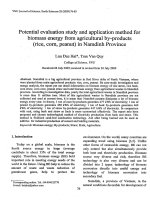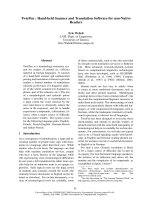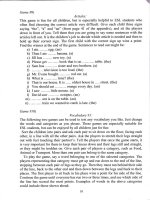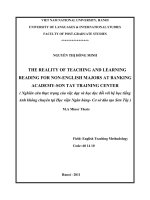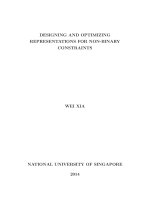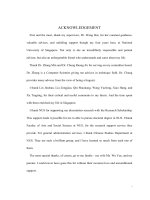Forensic accounting and fraud investigation for non experts 2 ed by howard silverstone
Bạn đang xem bản rút gọn của tài liệu. Xem và tải ngay bản đầy đủ của tài liệu tại đây (1.34 MB, 306 trang )
ch00_FM_4707
8/29/06
4:35 PM
Page i
Forensic Accounting
and Fraud Investigation
for Non-Experts
SECOND EDITION
Howard Silverstone
Michael Sheetz
WILEY
John Wiley & Sons, Inc.
ch00_FM_4707
8/29/06
4:35 PM
Page iv
ch00_FM_4707
8/29/06
4:35 PM
Page i
Forensic Accounting
and Fraud Investigation
for Non-Experts
SECOND EDITION
Howard Silverstone
Michael Sheetz
WILEY
John Wiley & Sons, Inc.
ch00_FM_4707
8/29/06
4:35 PM
Page ii
This book is printed on acid-free paper.
Copyright © 2007 by John Wiley & Sons, Inc. All rights reserved.
Published by John Wiley & Sons, Inc., Hoboken, New Jersey.
Published simultaneously in Canada.
No part of this publication may be reproduced, stored in a retrieval system, or transmitted in
any form or by any means, electronic, mechanical, photocopying, recording, scanning, or
otherwise, except as permitted under Section 107 or 108 of the 1976 United States Copyright
Act, without either the prior written permission of the Publisher, or authorization through
payment of the appropriate per-copy fee to the Copyright Clearance Center, Inc., 222 Rosewood Drive, Danvers, MA 01923, 978-750-8400, fax 978-646-8600, or on the web at
www.copyright.com. Requests to the Publisher for permission should be addressed to the
Permissions Department, John Wiley & Sons, Inc., 111 River Street, Hoboken, NJ 07030,
201-748-6011, fax 201-748-6008, or online at www.wiley.com/go/permissions.
Limit of Liability/Disclaimer of Warranty: While the publisher and author have used their
best efforts in preparing this book, they make no representations or warranties with respect
to the accuracy or completeness of the contents of this book and specifically disclaim any
implied warranties of merchantability or fitness for a particular purpose. No warranty may be
created or extended by sales representatives or written sales materials. The advice and strategies contained herein may not be suitable for your situation. You should consult with a
professional where appropriate. Neither the publisher nor author shall be liable for any loss
of profit or any other commercial damages, including but not limited to special, incidental,
consequential, or other damages.
For general information on our other products and services, or technical support, please
contact our Customer Care Department within the United States at 800-762-2974, outside
the United States at 317-572-3993 or fax 317-572-4002.
Wiley also publishes its books in a variety of electronic formats. Some content that appears
in print may not be available in electronic books.
For more information about Wiley products, visit our Web site at www.wiley.com.
Library of Congress Cataloging-in-Publication Data:
Silverstone, Howard.
Forensic accounting and fraud investigation for non-experts / Howard Silverstone,
Michael Sheetz.—2nd ed.
p. cm.
Includes bibliographical references and index.
ISBN-13: 978-0-471-78487-6 (cloth)
ISBN-10: 0-471-78487-7 (cloth)
1. Fraud investigation. 2. Forensic accounting. 3. Fraud—Prevention. I. Sheetz,
Michael. II. Title.
HV8079.F7S55 2007
363.25’963—dc22
2006015452
Printed in the United States of America
10
9
8
7
6
5
4
3
2
1
ch00_FM_4707
8/29/06
4:35 PM
Page iii
This book is dedicated to my family for putting up with so many Sunday
afternoons and late nights that I was enmeshed in the world of forensic
accounting.
—Howard Silverstone
This book is dedicated to Susan Sheetz, my wife, whose tireless patience,
endless encouragement, and unyielding optimism has made my life
immeasurably better.
—Michael Sheetz
ch00_FM_4707
8/29/06
4:35 PM
Page iv
ch00_FM_4707
8/29/06
4:35 PM
Page v
CONTENTS
Acknowledgments
ix
Part I
1
Fraud and Forensic Accounting Overview
1 FRAUD IN SOCIETY
3
WHAT IS FRAUD?
3
TYPES OF FRAUD
6
WHAT THE NUMBERS TELL US ABOUT FRAUD
11
THE SOCIAL CONSEQUENCES OF ECONOMIC CRIME
21
SUGGESTED READINGS
22
2 UNDERSTANDING THE BASICS OF FINANCIAL
ACCOUNTING
25
INTRODUCTION
25
THE FIVE ACCOUNTING CYCLES
27
JOURNALS
34
TYING THE THREAD
36
SUGGESTED READINGS
36
3 THE ENTITIES
38
PROPRIETORSHIPS
39
PARTNERSHIPS
39
CORPORATIONS
41
BUSINESS ENTERPRISES IN THE GLOBAL ENVIRONMENT
42
SUGGESTED READINGS
47
v
ch00_FM_4707
8/29/06
4:35 PM
Page vi
vi
Contents
4 FUNDAMENTAL PRINCIPLES OF ANALYSIS
GOOD ANALYSIS = DUE DILIGENCE?
49
WHY DO IT?
50
OTHER FACTORS TO CONSIDER
51
ANALYSIS FOR THE NON-EXPERT
52
TO THE FUTURE
58
SUGGESTED READINGS
59
5 THE ROLE OF THE ACCOUNTING
PROFESSIONAL
Part II
49
61
THE IMPORTANCE OF ACCOUNTING PROFESSIONALS IN THE
INVESTIGATION
61
THE AUDIT PROCESS
65
INTERNAL CONTROLS
68
Financial Crime Investigation
6 BUSINESS AS A VICTIM
71
73
INTRODUCTION
73
EMPLOYEE THEFTS
74
PAYROLL FRAUD
78
FRAUDULENT BILLING SCHEMES
80
FRAUD COMMITTED BY OUTSIDERS
81
MANAGEMENT THEFTS
82
CORPORATE THEFTS
85
IDENTITY THEFT
86
SUGGESTED READINGS
88
7 BUSINESS VILLAINS
INTRODUCTION
90
90
ORGANIZED CRIME AND BUSINESS
90
MONEY LAUNDERING
98
CONCLUSION
105
SUGGESTED READINGS
106
ch00_FM_4707
8/29/06
4:35 PM
Page vii
Contents
8 THE INVESTIGATIVE PROCESS
vii
111
INTRODUCTION
111
CASE INITIATION
112
CASE EVALUATION
114
GOAL SETTING AND PLANNING
116
INVESTIGATION
123
CONCLUSION
131
SUGGESTED READINGS
132
9 INTERVIEWING FINANCIALLY SOPHISTICATED
WITNESSES
134
INTRODUCTION
134
THE INTERVIEW
135
INTERVIEWING FINANCIALLY SOPHISTICATED WITNESSES
152
CONCLUSION
155
SUGGESTED READINGS
156
10 PROVING CASES THROUGH DOCUMENTARY
EVIDENCE
160
INTRODUCTION
160
DOCUMENT COLLECTION
161
DOCUMENT ORGANIZATION
176
THE PROCESS OF PROOF
180
THE LOGIC OF ARGUMENT
182
PROOF THROUGH INFERENCE
187
CONCLUSION
191
SUGGESTED READINGS
192
11 ANALYSIS TOOLS FOR INVESTIGATORS
196
INTRODUCTION
196
WHY USE ANALYSIS TOOLS AT ALL?
196
ASSOCIATIONAL ANALYSIS
198
TEMPORAL ANALYSIS
217
CONCLUSION
224
SUGGESTED READINGS
225
ch00_FM_4707
8/29/06
4:35 PM
Page viii
viii
Contents
12 INFERENTIAL ANALYSIS
INTRODUCTION
227
HOW INFERENTIAL ANALYSIS HELPS
227
WHAT IS AN INFERENCE NETWORK?
228
INVESTIGATIVE INFERENCE ANALYSIS
231
THE KEY LIST
237
CONSTRUCTING AN INVESTIGATIVE INFERENCE CHART
238
PLOTTING THE CHART
242
SOME TIPS FOR CHARTING SUCCESS
247
APPLYING THE CHART TO THE INVESTIGATIVE PROCESS
248
CONCLUSION
249
SUGGESTED READINGS
250
13 DOCUMENTING AND PRESENTING THE CASE
Index
227
254
INTRODUCTION
254
CREATING A SYSTEM
254
THE CASEBOOK SYSTEM
255
REPORT WRITING
263
TESTIFYING AS A FINANCIAL EXPERT
266
CONCLUSION
282
SUGGESTED READINGS
283
287
ch00_FM_4707
8/29/06
4:35 PM
Page ix
ACKNOWLEDGMENTS
I would like to thank my long-time colleagues and friends for their support,
especially Jim and Marie Stavros for helping me to realize the American
dream! Thanks also to Kip Hamilton, Steve Butler and others for their insight
and case examples. Extra special thanks to my wife Debbie, and my children,
Jonathan, Alec, and Emma, for their support. Thanks also to my mother,
Coba, for taking a 3,000-mile journey into the twenty-first century, and to my
father, Nat, whose spirit is still so strong.
—Howard Silverstone
I would like to thank Dr. Grace Telesco, who provided invaluable editorial and
organizational assistance during the preparation of this edition. Additionally,
I would like to thank my colleagues in academia, law enforcement, and the
court system, without whose comments, suggestions, and encouragement I
would not have been able to complete this work. In particular, I owe Gladys
Perez and Captain Richard Facchine an especially heartfelt thanks for all
their support and encouragement.
—Michael Sheetz
ix
ch00_FM_4707
8/29/06
4:35 PM
Page x
ch01_4707
8/28/06
2:04 PM
Page 1
PART I
FRAUD AND FORENSIC
ACCOUNTING OVERVIEW
ch01_4707
8/28/06
2:04 PM
Page 2
ch01_4707
8/28/06
2:04 PM
Page 3
1
FRAUD IN SOCIETY
“Yes! Finally captured Martha Stewart. You know, with all the massive
and almost completely unpunished fraud perpetrated on the American
public by such companies as Enron, Global Crossing, Tyco and Adelphia,
we finally got the ringleader. Maybe now we can lower the nation’s
terror alert to periwinkle.” 1
WHAT IS FRAUD?
Fraud is an activity that takes place in a social setting and has severe consequences for the economy, corporations, and individuals. It is an opportunistic infection that bursts forth when greed meets the possibility of deception.
The fraud investigator is like the attending physician looking and listening for
the signs and symptoms that reveal an outbreak.
The Association of Certified Fraud Examiners defines occupational fraud
as: “The use of one’s occupation for personal enrichment through the deliberate misuse or misapplication of the employing organization’s resources or
assets.”2
Before dealing with the accounting details and the investigation itself, we
introduce some attempts by the courts, law enforcement, and regulatory authorities to define fraud. Since the subject of this book is workplace fraud, we
then outline the nature of workplace fraud through a look at the accounting
cycle. We complete the tour with a look at the motives of fraudsters and the
consequences of their acts.
The modern definition of fraud is derived primarily from case and statute
law, but many of the ancient elements remain. Those roots can be traced to
fraus, a Latin noun carrying a wide range of meanings clustered around the
3
ch01_4707
4
8/28/06
2:04 PM
Page 4
Forensic Accounting and Fraud Investigation for Non-Experts
notions of harm, wrongdoing, and deceit. The modern definition derived from
case law focuses on the intent of the fraudster(s) to separate the trusting victim from property or a legal right through deception for his or her own benefit. This deception involves any false or misleading words or actions or
omissions or concealment of facts that will cause legal injury. Criminal prosecution of fraud must prove beyond a reasonable doubt that an act meeting the
relevant legal definition of fraud has been committed by the accused. In civil
cases, liability must be demonstrated on a balance of probabilities.
White-collar crime should be viewed as a subclass of fraud. Fraud includes
confidence schemes, art forgery, falsified scientific research data, lying on a
resume, and so on. White-collar crime, however, is committed by individuals
embezzling, manipulating accounts, taking bribes, and so on at their place of
business. What they all have in common, however, is the intent to deceive.
This book limits its discussion to the field of white-collar crimes committed
against businesses and their accounting systems and will not discuss consumer
and other types of fraud. The forensic accounting techniques discussed below
are central to the discovery of fraud in the business environment.
U.S. Supreme Court Definition of Civil Fraud
Fraud takes many forms, and the courts and other institutions have had a hard
time finding a definition broad, yet specific, enough to give anything beyond
a working definition. While there may not be one definitive all-encompassing
definition, it is clear that the public and those not involved every day in its detection have a better understanding than perhaps even five years ago.
The U.S. Supreme Court in 1888 provided a definition of civil fraud as:
First: That the defendant has made a representation in regard to a material fact;
Second: That such a representation is false;
Third: That such representation was not actually believed by the defendant, on
reasonable grounds, to be true;
Fourth: That it was made with intent that it should be acted on;
Fifth: That it was acted on by complainant to his damage; and
Sixth: That in so acting on it the complainant was ignorant of its falsity, and reasonably believed it to be true. The first of the foregoing requisites excludes such
statements as consist merely in an expression of opinion of judgment, honestly
ch01_4707
8/28/06
2:04 PM
Page 5
Fraud in Society
5
entertained; and again excepting in peculiar cases, it excludes statements by the
owner and vendor of property in respect of its value.3
FBI Definition of Fraud
The Federal Bureau of Investigation (FBI) offers a broad but useful definition
of fraud that incorporates the elements recognized over the centuries:
White-collar crimes are characterized by deceit, concealment, or violation of
trust and are not dependent upon the application or threat of physical force or
violence. Such acts are committed by individuals and organizations to obtain
money, property, or services; to avoid the payment or loss of money or services;
or to secure a personal or business advantage.4
Financial fraud, the subject of this book, is criminal fraud of the whitecollar type. It is committed against businesses by both employees and outsiders such as vendors and contractors. Sadly, this type of crime has also
gone beyond the typical “business” or commercial organization. Case in point
is highlighted in a recent article entitled “Stealing from the Collection Plate,”
where it was noted, “Churches and religious groups are at greater risk for financial misconduct because of the nature of their missions and management
structures.”5
SEC Definition of Fraud
The U.S. Securities and Exchange Commission (SEC) has its own definition
of fraud as it applies to transactions involving securities. Although the law
governs securities, the principles invoked reiterate the constellation of ideas
central to definitions of fraud with broader application. The Securities Exchange Act of 1934, Section 10b-5, states:
It shall be unlawful for any person, directly or indirectly, by the use of any
means or instrumentality of interstate commerce, or the mails, or of any facility of any national securities exchange,
a) to employ any device, scheme, or artifice to defraud,
b) to make any untrue statement of a material fact or to omit to state a material fact necessary in order to make the statements made, in the light of the
circumstances under which they were made, not misleading, or
ch01_4707
8/28/06
6
2:04 PM
Page 6
Forensic Accounting and Fraud Investigation for Non-Experts
c) to engage in any act, practice, or course of business which operates or would
operate as a fraud or deceit upon any person, in connection with the purchase
or sale of any security.
TYPES OF FRAUD
White-collar fraud involves an intentional deception by employees, management, vendors, and customers to obtain money or other assets or services from
a business. Some frauds are perpetrated by individuals and some in collusion
across the management–employee social boundaries or between insiders and
outsiders. The most useful way to classify the activity of the fraudster is to discuss briefly the five typical accounting cycles of any business where it will
likely leave some kind of audit trail. The five cycles follow:
1.
2.
3.
4.
5.
Sales and Collections
Purchases and Payments
Payroll and Personnel
Inventory and Warehousing
Capital Acquisition and Repayment
Sales and Collections Cycle
The sales and collections cycle bills clients for sales of goods and services and
collects the money. This is the most cash-intensive of the five cycles. The most
common frauds in this cycle are:
•
•
•
•
Outright cash thefts
Theft of other assets
Kickbacks to customers
Front-end frauds
Outright Cash Thefts Cash thefts are the easiest and most common type of
fraud to perpetrate in this cycle and are usually carried out through unrecorded
sales, underringing of sales, lapping schemes, and overbilling, among others.
Theft of Other Assets Assets can be stolen by ordering and shipping goods
to an address other than that of the business.
ch01_4707
8/28/06
2:04 PM
Page 7
Fraud in Society
7
Kickbacks to Customers In customer kickback schemes, the fraudster underbills the customer for merchandise and they split the difference or receivables are written off as uncollectible for a fee.
Front-End Frauds Front-end frauds are committed by the fraudster directing
customers to take their business elsewhere or misappropriating a rebate.
Purchases and Payments Cycle
This cycle includes non-capital procurements and payments for goods, equipment, and services used in company operations. The buyer may act alone by
setting up shell companies to receive goods misdirected from his company
by false invoices. These schemes are often extremely complex and involve
bank accounts, mail drops, and even corporate filings for the dummy entities.
Procurement fraud is frequently a collusive employee–vendor fraud. The
vendor will typically provide a bribe or kickback in return for business or, in
the case of tendered contracts, for the employee to rig the bidding in favor
of the fraudulent vendor. In another scheme, which may or may not be related
to the original procurement scheme, once the vendor has been awarded
the contract, the cost of the bribe may be recovered and profits increased by
substituting products inferior to contract specifications, billing for work
not done, shipping less than ordered, padding overhead expenses, and so
on. Collusive fraud is the most common form of acquisition-and-payment
fraud.
Payroll and Personnel Cycle
This cycle deals with hiring and termination, salaries, timekeeping, expense
account reimbursements, and health and other types of employee insurance
coverage. Common forms of fraud in this cycle are paying ghost employees,
overstating hours worked, overstating expenses, and filing false medical
claims. Employee and management fraud can overlap in this cycle, especially
in the area of false expense account reports. An important but often overlooked area of personnel fraud is the improper vetting of job applicants. Collusion between a personnel department employee and a fraudster applicant
could install a fraudster within the company with untold consequences.
ch01_4707
8
8/28/06
2:04 PM
Page 8
Forensic Accounting and Fraud Investigation for Non-Experts
Inventory and Warehousing Cycle
This cycle controls the purchase and storage of goods for later processing and
sale or just for sale. The most common frauds in this cycle are ordering unneeded inventory and then stealing it for personal use; committing outright
theft; and charging embezzlements occurring elsewhere in the company to inventory losses. These schemes can often become extremely complex and involve loading-dock workers, inventory accounting personnel, truck drivers,
and receivers of stolen goods in other parts of the state or country.
Capital Acquisition and Repayment Cycle
This cycle accounts for debt and equity financing, interest, and dividend payments. The results of these transactions are reflected on the financial statements of the company. Because these accounts are developed at the executive
level, this type of fraud is committed almost exclusively by management. The
usual frauds are borrowing company money for personal use, misuse of interest income, and misuse of proceeds from financings.
Other Types of Financial Fraud
Some frauds that affect business often occur outside the typical accounting
cycle. Customer fraud, for example, can severely affect insurance companies
through filing of false applications and fraudulent claims, especially those for
personal injury. Banks and other financial institutions suffer customer fraud
through submission of false financial information on loan applications.
Management fraud deserves special mention in these days of corporate
scandals. In addition to theft through the capital acquisition and repayment
cycle, management can commit fraud through the manipulation of earnings reported on the financial statements prepared for shareholders and creditors.
This type of fraud can affect the stock price, management bonuses, and the
availability and terms of debt financing. Enron, WorldCom, Global Crossing,
and many others are particularly egregious examples of management manipulation of the financial statements that enriched a few but caused the collapse
of company pension plans, enormous losses to innocent shareholders, and unemployment for thousands of staff. These frauds have also contributed to the
downfall of a major accounting firm (Arthur Andersen), a spate of suits
ch01_4707
8/28/06
2:04 PM
Page 9
Fraud in Society
9
against others, and the decline in the public’s confidence in the accounting
profession.
As we discuss later in this book, fraudsters often rationalize their deeds by
claiming “I wasn’t hurting anyone”—clearly, this is far from reality.
Recent Corporate Fraud in Perspective It is sometimes suggested that the
size and complexity of the Enron, WorldCom, Global Crossing, and other
cases mean we are living in a new era of fraud. What should we make of this
suggestion? Is this a new phenomenon, or is it because we are in the age of
“real-time” reporting (news hits us instantly, rather than when it isn’t “new”
anymore)? Instant news means instant reaction—the media searches for instant answers, perhaps before even those of us considered experts have had a
chance to digest, reflect, and then comment.
Perhaps, rather than being trend-setting events, these scandals are merely
the latest in a history of revelations that have always followed market excesses
since the Dutch Tulip Mania of the 1630s.6 The dot-com bubble of the late
1990s was no exception. The English polymath Walter Bagehot captured all
the elements of excess in the following passage from Lombard Street, his 1873
critique of the English banking system:
The mercantile community will have been unusually fortunate if during the period of rising prices it has not made great mistakes. Such a period naturally excites the sanguine and the ardent; they fancy that the prosperity they see will last
always, that it is only the beginning of a greater prosperity. They altogether overestimate the demand for the article they deal in, or the work they do. They all in
their degree—and the ablest and the cleverest the most—work much more than
they should and trade far above their means. Every great crisis reveals the excessive speculations of many houses which no one before suspected, and which
commonly indeed had not begun or had not carried very far those speculations,
till they were tempted by the daily rising price and the surrounding fever.7
A Bit of Background The great bull markets of the twentieth century were all
followed by revelations of malfeasance that only came to light after equity values had declined from heights unjustified by earnings growth rates and historical price-earnings multiples. When the Jazz Age ended in October 1929,
the reputation of business executives was in just as much trouble as it is
today. The shenanigans of the bigger players were ultimately exposed when
the investigations of the Senate Committee on Banking and Currency in 1933–
ch01_4707
10
8/28/06
2:04 PM
Page 10
Forensic Accounting and Fraud Investigation for Non-Experts
1934 revealed the true behavior and ethics of the bankers and brokers in the
previous decade. The practices of the great financiers of the day as presented
in 12,000 pages of testimony were so shocking that the government felt it necessary to establish the Securities and Exchange Commission in 1934 to regulate the financial industry.
Richard Whitney, head of his own investment firm and five times president
of the New York Stock Exchange, proved to be an exceptionally poor businessman. He borrowed $30 million from his friends, relatives, and accounts
in his trust and owed $6.5 million at the time he declared bankruptcy. He
served three years and four months of a five- to ten-year sentence for misusing funds from his father-in-law’s estate.
The More Things Change . . . We may have short memories, but let’s just go
back to the bull market of the mid-1980s, which was a time of merger mania
and the heyday of the junk bond market. The crime du jour was insider trading. The investment banker Drexel Burnham Lambert collapsed, and Denis
Levine, Ivan Boesky, Michael Milken, and others went to jail.
Perhaps we can learn from previous experience to avoid overlooking
possibilities of fraud into the future. Look no further than www.theprosand
thecons.com, a speakers’ bureau that employs experts and ex-cons to help
companies avoid and detect fraud. Fraudster-turned-consultant Frank Abagnale has spent the past 30 years working with the FBI and lecturing on fraudtechniques. Abagnale was the subject of the 2002 movie Catch Me If You Can.
Comments director Steven Spielberg, “I did not make this film about Frank
Abagnale because of what he did . . . but because of what he has done with his
life the past 30 years.”8
Sarbanes-Oxley The purpose of the Sarbanes-Oxley Act of 2002 was to provide investors with greater confidence in American corporations and allow
them to rely on financial statements as an accurate representation of the financial condition of the companies in which they are stakeholders. The Act
was a response to the revelations of lax auditing practices and conflicts of interest between auditors and their clients.
This book will not discuss Sarbanes-Oxley in great detail, as much has been
written about it elsewhere. However, what is key is to look at the Act’s effect
and how its effectiveness is perceived.
In its “2005 Oversight Systems Report on Corporate Fraud,” Oversight
Systems9 surveyed certified fraud examiners “to report the trends, risks and
ch01_4707
8/28/06
2:04 PM
Page 11
Fraud in Society
11
major concerns that businesses face today.” Oversight noted that while most
examiners saw Sarbanes-Oxley as an effective tool, “few think it will change
the culture of business leaders.” That is a very telling comment. Whether we
discuss the Dutch Tulip Mania, the heady days of insider trading, or recent
corporate scandals, what we need to realize is that perhaps we cannot stop
fraud from happening, but we can limit the vehicles that allow it. We discuss
later in this book Business as a Vehicle; most worrying is that similar to automobiles, when one model becomes obsolete, another is sure to follow. Just
because certain types of business scandals are behind us, this does not mean
new methods will not ensue.
WHAT THE NUMBERS TELL US ABOUT FRAUD
Comprehensive concrete and official fraud statistics are hard to come by because government agencies and industry groups tend to keep records only of
those frauds that affect their area(s) of interest.
We must also remember that all fraud statistics are based on known frauds.
What is most unnerving is the fact that the numbers quoted are considered to
be only the tip of the iceberg. Aside from the many undetected frauds are
those frauds not reported by the harmed organization for fear of embarrassment. Many organizations would rather complete an investigation and move
on, than bring to public light the full extent of a fraud perpetrated against
them.
Notwithstanding the uncertainty of the true extent of financial fraud, there
are studies that shed light on the enormous impact.
Study: Association of Certified Fraud Examiners
For purposes of this book, the best overview of financial fraud comes from
studies done by the Association of Certified Fraud Examiners (ACFE). In
1996, the ACFE published Report to the Nation on Occupational Fraud and
Abuse based on occupational fraud cases reported by its members. In its 2004
Report to the Nation on Occupational Fraud and Abuse, the results were
based on a study of 508 cases reported by the Certified Fraud Examiners
(CFE) who investigated them.10 These reported cases resulted in over $761
million of losses. The ACFE estimates that applied to the Gross Domestic
Product, this translates to approximately $660 billion in total losses. This is a
ch01_4707
8/28/06
12
2:04 PM
Page 12
Forensic Accounting and Fraud Investigation for Non-Experts
significant increase over the $400 million estimated to have been lost in 1996
when the first report was written.
Small-Business Fraud
According to the ACFE study, “small businesses suffer disproportionately
large losses due to occupational fraud and abuse.” The median loss for these
businesses was $98,000, which was higher than for all but the very largest
companies.
Frauds committed by owners and executives caused a median loss of
$900,000, six times higher than losses caused by managers and 14 times
higher than losses caused by employees. However, the study added that companies are less likely to take legal action against owners than against employees.
Additionally, only 12 percent of fraudsters in the study had previous convictions for a fraud-related offense. To reiterate what we said earlier, one
should keep in mind that, although the billion-dollar scandals at Enron, WorldCom, and other corporations have splashed onto the front pages in recent
times, it is the slow, steady drip, drip, drip of fraudulent activity at small businesses that is larger in aggregate and potentially does the greater damage to
the economy over the long run. Also, while you may make one vehicle obsolete, newer generations of fraudsters will create new models to perpetrate
their crimes.
Categories of Occupational Fraud
The ACFE divides occupational fraud into three broad categories:11
1. Asset misappropriation
2. Corruption
3. Fraudulent statements
Asset Misappropriation Asset misappropriations are the theft or misuse of assets and account for 90 percent of all occupational fraud in the study. It is
pointed out in the study that these schemes have the lowest median loss
($93,000), while fraudulent statements, the subject of much news surrounding WorldCom et al., only occurred in 7.9 percent of the reported frauds, but
had the highest median loss at $1 million.
ch01_4707
8/28/06
2:04 PM
Page 13
Fraud in Society
13
Cash thefts usually occur in three different ways:
1. Fraudulent disbursements
2. Skimming
3. Cash larceny
FRAUDULENT DISBURSEMENTS Fraudulent disbursements use some device
such as false invoices or timecards to create a false payment obligation for a company. It is the most common type of cash fraud, accounting for 74.1 percent of the
studied cases and creating a mean loss of $125,000.
Fraudulent disbursements break down into five principal types:
1. Billing: Fraudulent billing schemes accounted for 52.1 percent of
fraudulent disbursements and created a median loss of $140,000.
2. Check tampering: Check tampering made up 31.3 percent, with a median loss of $155,000.
3. Expense reimbursement: Expense reimbursements comprised 22.1 percent of schemes and caused a median loss of $92,000.
4. Payroll: Payroll schemes represented 19.6 percent of cases studied,
and the median loss was $90,000.
5. Register disbursement: Register disbursements made up only 4.3 percent, with the smallest median loss of the group at $18,000.
SKIMMING Skimming is the theft of cash during its collection but before it
is recorded on the company books. Skimming occurred in 28.2 percent of the
cash frauds and showed an $85,000 mean loss.
CASH LARCENY Cash larceny is the theft of cash after it has been recorded.
This form of fraud accounted for 23.9 percent of the cases, with a mean loss
of $80,000.
Drawing Conclusions
Returning to the Oversight Systems survey, 52 percent of those surveyed believed Sarbanes-Oxley has been effective in helping identify instances of financial statement fraud. Remember, Sarbanes-Oxley relates solely to public
companies. However, the survey also revealed that 67 percent of those surveyed believed institutional fraud is more prevalent today than five years
